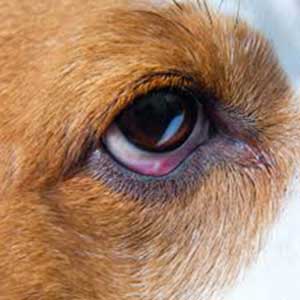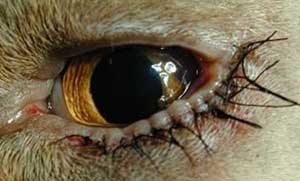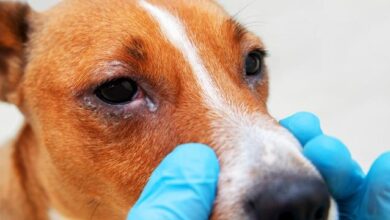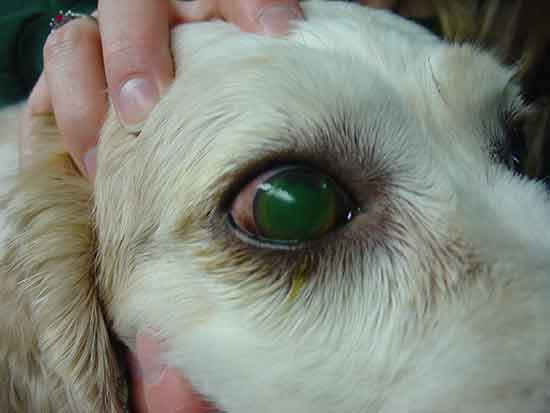
When our furry friends gaze up at us with those big, expressive eyes, it’s hard not to feel a surge of affection. Our dogs’ eyes are not just windows to their souls but crucial indicators of their health. As we move into 2024, understanding dog eye problems has never been more important. This year brings new insights and advanced treatments, but also some familiar challenges. From tear stains and cataracts to glaucoma and cherry eye, there are a variety of eye conditions that can affect our pups. Let’s delve into the eight most common dog eye problems you’ll encounter in 2024 and explore how to keep those loving eyes bright and healthy.
Read More:
- Which Dogs Have the Worst Health Problems?
- Dog Allergies: Symptoms and Cures
- 8 Famous Dog Breeds with the Most Health Issues
- 7 Fascinating Things To Know About Snakes Before Bringing Home One
- How Do Dogs Communicate With Humans
Most Common Dog Eye Problems
1. CORNEAL ULCER
Corneal ulcer, or sometimes known as ulcerative keratitis, is an inflammatory condition of the cornea involving erosion of its outer layer. Dogs suffering from this eye problem will have red and painful eyes which tear excessively and are sensitive to light. Most of the time, they tend to rub the affected eye with paws, which unfortunately could lead to prolongation of the healing process and further damage to the cornea.
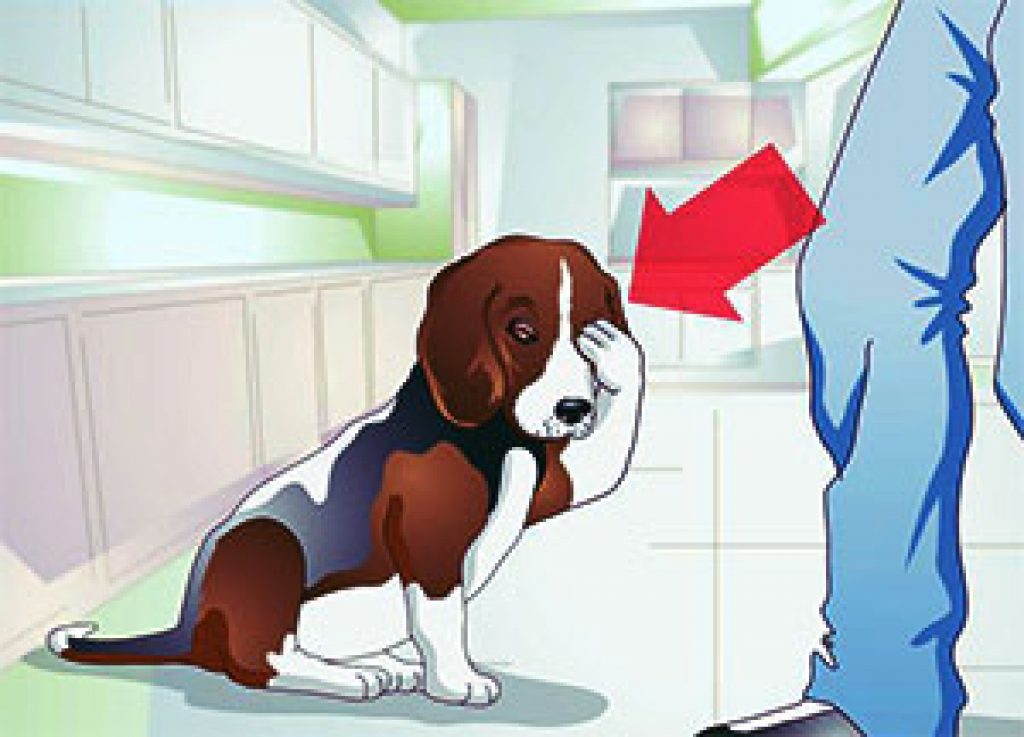
causes of corneal ulcer
Common causes of corneal ulcer include trauma, which may simply be the result of dog rubbing an itchy eye, or due to laceration followed from the cat scratch or contact with the sharp object. It may also be caused by the chemical burn of the cornea, which happens after contact with irritating substances such as shampoo or cigarette smoke. Less commonly, the corneal ulcer could be caused by bacterial or viral infections that may originate in the eyes or develop secondary to a disease elsewhere in the body.
A corneal ulcer could cause a great deal of irritation and discomfort to dogs. If left untreated, it may contribute to vision loss, either temporary or permanent and in some situations even loss of the eyeball itself. Hence, it is better to be safe than sorry so an early visit to the veterinarian is a wise precaution.
Treatment of corneal ulcer
Treatment of corneal ulcer depends upon its severity, whether how many layers of corneal tissue are being involved. First aid measure usually involves gently bathing with cold water and parting the eyelids to see if there is any foreign body in the eyes.
For simple and superficial corneal ulcers, the main treatment option includes topical eye preparations which contain broad-spectrum antibiotics or anti-fungal ingredients in order to manage and prevent infection. For best results, these preparations should be applied every four to six hours, depending on the dog’s condition and acceptance of the medication.
To maximize the treatment effect, atropine ophthalmic solution is often prescribed to dilate the pupils and normalize eyeball pressure, resulting in the relief of pain and discomfort. This medication is only needed every twelve to forty-eight hours as it generally lasts longer.
During the treatment and healing period, it is recommended to follow the veterinarian’s instructions and try to limit the dog’s activity if possible. With prompt treatment and care, superficial corneal ulcer generally heals within a week. For ulcer that is slightly more severe and fairly deep, extensive pharmacological treatment or surgical intervention would be necessary and the cornea should be healed in two weeks after the treatment.
2. CATARACTS
Cataract, the cloudiness in the crystalline lens of a dog’s eye, is one of the common reasons that cause dogs to have blurry vision. The symptoms of cataracts in dogs relate to the severity of vision impairment, which is further determined by the degree of cloudiness, varying from complete to partial opacity.
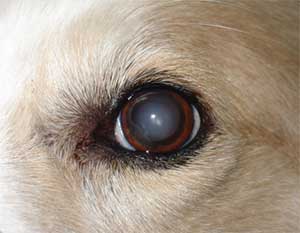
Dogs with cataracts covering less than 30 percent of the lens are usually asymptomatic, whereas those with more than 60 percent of lens opacity are more likely to suffer from diminished vision and have difficulty seeing in dimly lit areas.
Causes of cataracts
Dog cataracts can develop for a variety of reasons, including advanced age and the secondary effects of diseases such as diabetes or progressive retinal atrophy. Studies indicated that about 75% of dogs develop blinding cataracts within the first nine months of suffering from diabetes.
Most commonly, cataracts in dogs are hereditary and vary in different breeds in terms of their anatomic position within the lens, their age of onset, and their progressive or stationary nature.
If your dog is having cloudy pupils or starts showing signs of vision impairment such as tripping and bumping into walls, then it is time for you to seek veterinary advice as there could be a high possibility that your dog is suffering from cataracts.
Treatment of cataracts
It is important to not delay the treatment of cataracts as it could eventually lead to blindness in one or both of the dog’s eyes. To date, the only effective treatment for cataracts is surgery, which goals are to restore the dog’s vision and prevent the secondary sequelae of cataracts such as glaucoma, uveitis, and retinal detachment.
This type of surgery generally has a good success rate, however, it is not recommended for dogs with non-hereditary forms of cataracts. Dog cataracts are not preventable in most cases, but their progression could be delayed with a regular eye examination and prompt treatment of underlying diseases such as diabetes and eye trauma.
3. GLAUCOMA
Glaucoma is one of the common dog eye problems which is characterized by the abnormal buildup of fluid (aqueous humor) inside the eyes. It occurs as a result of inadequate fluid drainage inside the eyes which causes a buildup of painful pressure within the eyes.
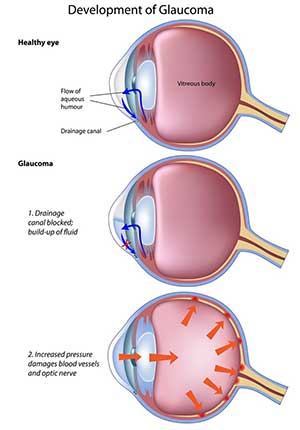
If the fluid buildup is left untreated, the eyes would continue to enlarge and cause permanent damage to the optic nerve, resulting in irreversible blindness.
Causes of glaucoma
The causes of glaucoma in dogs could be further classified as primary or secondary.
Primary glaucoma is an inherited condition that affects certain breeds of dogs such as cocker Spaniels, Samoyeds, poodles, chow chows, and Siberians, whereas secondary glaucoma occurs with the presence of other eye diseases which inhibits the drainage of fluid inside the eyes. Examples of diseases include uveitis (inflammation of the interior of the eyes), lens dislocation, eye tumors, and chronic retinal detachment.
Dogs suffering from this eye condition will have red and cloudy eyes accompanied by an abnormal ocular discharge. They may be lethargic, depressed, and start showing signs of vision impairment such as stumbling over and bumping into normal objects.
Other early signs include changes in the appearance of the pupils, which may be dilated and not contract quickly in response to light. When these symptoms occur, it is important for the dog owner to seek veterinary advice as soon as possible to reduce the risk of irreversible damage and blindness.
Usually, analgesics will be prescribed to relieve the pain and discomfort associated with this condition. Medications that decrease fluid production and promote drainage are also necessary to treat the increased intraocular pressure. While there are no known ways of preventing glaucoma, taking your dog for a regular eye check-up is the most effective way to reduce the overall risk of its development. Besides, a healthy diet that is high in antioxidants such as beta-carotene and vitamins could also benefit your dog and delay the development of glaucoma.
4. CHERRY EYE
Cherry eye, a condition that causes dogs to develop a red bulge in their eyes, is one of the common dog eye problems. Affected dogs may suffer from eye dryness, swelling, and pain. The reasons which cause cherry eye is not well understood, but it is thought that the cause could be from a parasite, bacterial infection, cancer, dermatitis, or possible sun damage. Besides, genetics also play a large role in the development of the disease as it is commonly associated with a congenital weakness of the connective tissues around the third eyelid.
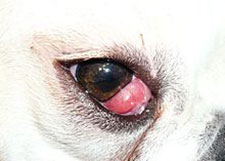
Image source: Wikipedia
One good news is that cherry eye is not a life-threatening condition. When treated early, it could be reversible and will not result in permanent ocular damage. Hence, dogs with cherry eyes should consult the veterinarian and be treated promptly. Primary treatment options include treatment with topical antibiotics, anti-inflammatory agents, and also surgical replacement of the gland in the dog’s eye. However, despite its effects in reducing inflammation and preventing secondary infection, topical therapy is rarely successful in curing cherry eye and hence its use in this condition is not recommended.
5. CONJUNCTIVITIS
Conjunctivitis, or preferably known as pink eye, is a medical condition that involves the inflammation of the conjunctiva, a type of membrane that covers the front part of the eyeball and also lines the eyelids. Affected dogs often have reddened and swollen eyelids accompanied by abnormal stringy drainage which could cause a great deal of discomfort.
Causes of conjunctivitis
There could be a wide range of causes that lead to the development of this common disease. Primary causes include bacterial or viral infections, immune system problems, cancer, or physical irritation possibly caused by foreign bodies like dust and inward growing eyelashes. Apart from that, it could also be thought of as a symptom secondary to other prominent diseases such as corneal ulcer, anterior uveitis, or glaucoma.
Similar to other common dog eye problems, conjunctivitis requires immediate medical attention as delayed treatment could result in permanent damage to the cornea and surrounding ocular tissues. First-aid measures involve the removal of irritants from the eyes using sterile saline eye washes as well as soothing the affected areas with analgesics.
Treatment
For conjunctivitis caused by bacterial infections, the preferred treatment option would be the use of broad-spectrum antibiotics in the form of eye drop or ointment in order to manage the infection. However, if the cause is an allergy, it would be necessary for dog owners to try to minimize their dogs’ exposure to airborne irritants such as dust and cigarette smoke. In many cases, conjunctivitis is actually preventable. Some of the preventative strategies include scheduled vaccinations against diseases that could contribute to conjunctivitis, and also keeping the hygiene of dogs.
6. DRY EYE
If you ever noticed your dog with red, swollen inflamed eyelids or dull dry cornea accompanied by thick yellow discharge, there could be a high possibility that it is suffering from a medical condition known as dry eye. Dry eye, or technically known as keratoconjunctivitis sicca, is one of the painful and potentially dangerous dog eye problems caused by inadequate production of tears.
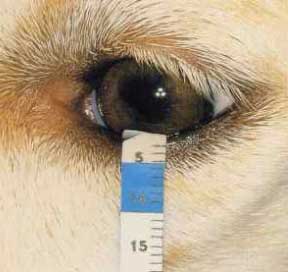
It is common for an affected dog’s cornea and conjunctiva to become dry, red, and inflamed due to a lack of adequate lubrication. However, if not diagnosed and managed, it could turn into a severe case and lead to complications such as painful corneal ulceration, impaired vision, and even blindness.
Cause of dry eye
The cause of dry eye is not well understood, but it is believed that autoimmunity plays a big role in the development of the disease. In this case, the body’s immune system tends to self-attack the tear gland tissue, resulting in decreased production of tears which leads to inadequate lubrication of the eye. Some other causes include canine distemper virus or feline herpes virus infection, medications such as sulphonamides, and also hypothyroidism.
Treatment
As for the treatment of this dog’s eye problem, cleansing the eyes several times a day with warm water will help the dog to feel better and could stimulate its tear film production. Furthermore, two common ophthalmic medications could also be used once or twice daily to stimulate the production of tears, namely cyclosporine and tacrolimus.
These agents act by suppressing the dog’s immune system, hence reversing the immune-mediated damage to tear glands and restoring tear production. It is important to note that dry eye condition is not curable and hence life-long medical care is needed for the successful outcome of this disease. Unfortunately, there is currently no known preventative measure for this medical condition. The only thing that we could do is not to breed dogs with this problem so as not to pass on this trait to any offspring.
7. ENTROPION
Entropion is one of the common dog eye problems that involve the genetic abnormality of the eyelids, causing a portion of the eyelid to invert or fold inwards. The inward folding often causes the hair on the surface of the eyelid to rub against the cornea, resulting in friction, irritation, and discomfort that can severely damage the eye.
Causes of entropion
Causes of entropion can be further divided into primary or secondary. Primary entropion is defined as a congenital anomaly in facial conformation and eyelid support. It is much rarer than secondary entropion, which is caused by eyelid spasms, eyelid trauma, infection, or obesity.
Clinical signs of entropion include excessive tearing, swollen red eyes accompanied by thick ocular discharge, squinting, and intolerant of light. Since it is extremely painful, it is advisable for dog owners to apply some analgesic medications in the form of eye drop and ointment in order to alleviate the pain and relieve the discomfort.
Treatment
However, the only truly effective treatment for this condition would be a surgical correction, which involves the removal of the skin section from the affected eyelid to reverse the inward folding. It is critical for dog owners to carefully follow the veterinarian’s treatment plan to maximize the likelihood of a successful outcome. In most cases, prevention is not possible for primary entropion. Secondary entropion could be prevented or at least reduced by having an eye injury examined and treated.
8. ECTROPION
Characterized by a droopy lower eyelid, ectropion is one of the common dog eye problems that involve the abnormality of the lower eyelid, causing them to roll outward or become everted. Dogs with this eye problem often acquire conjunctivitis or corneal ulcer, possibly due to drying of the conjunctival tissues and cornea after long-time exposure to air. Ectropion usually has a strong genetic component, which dogs with loose facial skin are predisposed to this disorder. Other common causes include contact with foreign bodies, trauma, weight loss, or loss of facial muscle tone around the eyes due to old age.
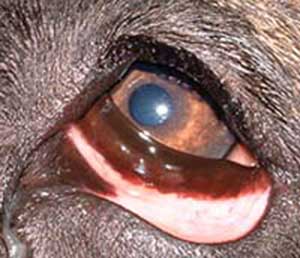
Dogs suffering from ectropion will have pronounced droopy lower eyelid, swollen or red conjunctiva, watery eyes as well as ocular inflammation. Once you notice such symptoms with your dog, it is important to make a prompt veterinary appointment in order to reduce the risk of more serious secondary problems.
Treatment
Treatment of this problem depends on its severity. Mild to moderate cases generally requires medical treatment with topical lubricants to prevent the cornea and conjunctiva from drying out, thus reducing the risk of acquiring conjunctivitis and corneal ulcer. Moreover, to maximize the treatment effect, it is advisable for the dog’s owner to focus on the need for regular and thorough facial hygiene. Surgery could be performed if the condition is severe. For the prevention of ectropion, affected dogs should probably not be bred to prevent the transmission of the defect.
In conclusion, dog eye problems must not be overlooked and they must be evaluated and treated promptly to prevent any complication that could eventually lead to irreversible blindness of the eyes. Since dogs are our faithful companions of life, it is always our responsibility to keep them healthy, happy, and content. Thanks for reading! Please share this post and help people to know about common dog eye problems.
Popular Post:
- Best Dog Food Review 2020
- Most Trainable Dogs 2020
- Canidae Dog Food Review
- How to Get Your Dog to Stop Barking
- The Truth About Silver Labs
- Is Your Dog a Velcro Dog?
- Teddy Bear Dog Breeds
- Dog Coughing up Blood
- American Pitbull Breeders
- Is argan oil safe for dogs?
- Dog Food Advisor
- Dogs under 40 pounds
